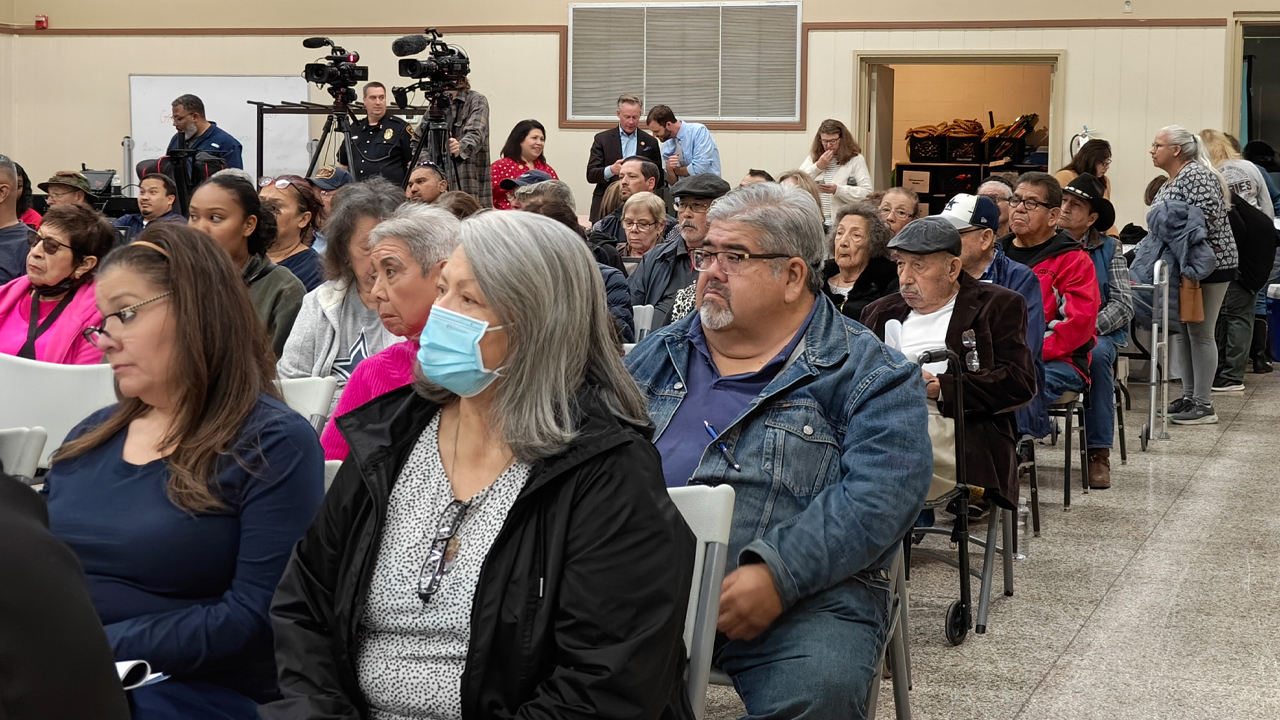(Photo above: Electric competition town hall meeting in the Maggie Trejo Supercenter)
You had questions – we have some answers.
The Nov. 16 LubbockLights.com story about Lubbock’s upcoming switch to competitive electric providers featured questions people asked at a Maggie Trejo Supercenter meeting.
The story led to even more questions on our Facebook page. We’ll get to those in just a bit.
Starting in March, no one in Lubbock will purchase electricity from Lubbock Power & Light but instead will choose a power provider.
The first day to begin choosing a provider is January 5 and the last is February 15. Those who do not choose will be placed with one of three default providers. You can meet companies face-to-face during a series of “shopping fairs” at the Civic Center in January and February. (See the schedule below.)
Beware of door-to-door salespersons who must have a peddler permit from the city and must be on a list of power companies authorized to sell in Lubbock.
Also, as part of this big switch, roughly 30 percent of LP&L customers will lose power for up to a half hour during the weekend of December 9 and 10 while electric lines are changed over from one grid system to another.
Here are some of your questions, answered by Matt Rose, Lubbock Power & Light’s public affairs and government relations manager.
Is this change only for residential or also commercial?
“This is for all customer bases,” Rose said, meaning homeowners, renters, businesses, government agencies and big industries.
“Do I have to switch to another company just for water?” asked a woman who has South Plains Electric Coop for electricity.
“No,” Rose answered. “And she is not affected by this at all. The only people who are affected by this are LP&L electric customers.”
“If your name is on the bill, it’s your choice? Will landlords be taking umbrage with that?”
Whoever pays that bill gets to make the decision, Rose said.
Would nearby cryptocurrency mines which use a lot of power cause a problem for price stability?
No, Rose said. Bitcoin mining and cryptocurrency will not affect electric costs in Lubbock.
A man wanted assurances about customer service.
Rose said powertochose.org will soon list Lubbock plans. “We put a strong emphasis on customers looking at the customer service ratings that are listed on that website,” Rose said.
“I thought LP&L was still going to be one of the choices in the mix. I thought we would be able to stay with them if we wanted to. Now I have anxiety.”
It’s important for LP&L to just focus on making sure the electric lines are reliable, Rose said. Other companies can focus on providing power.
“What happens to the deposit when I had to start with LP&L?”
“If you still have a deposit with LP&L in March, it will be returned, Rose said, adding there’s a chance you might be asked to make a deposit with your new provider.
There might be a way to get out of the deposit with the new providers by using the city’s website. “Log on to City of Lubbock Utilities,” Rose said. “There’s a 12-month letter of credit in there that folks can use.”
Why not just leave things as they are?
Perhaps the most complicated question that popped up on Facebook was why things need to change at all.
For that, we need to go back to 2005 when LP&L and Xcel Energy both had customers in Lubbock. LP&L was generating some but not all of its own electricity.
Xcel sold wholesale power to L&PL, but a lawsuit in the Permian Basin made Xcel change the way it did business. One thing led to another, and Xcel sold its Lubbock business to LP&L. Competition came to an end.
Over the years people liked having a choice and wanted it back, said Rose.
While looking to replace wholesale power from Xcel, LP&L had to decide if it would remain with a national power grid called the Southwest Power Pool or a different power grid called ERCOT, the Electric Reliability Council of Texas.
ERCOT was cheaper, and once LP&L became established with new suppliers in ERCOT, big contracts worth tens of millions of dollars would be difficult and expensive to break.
“The decision was made that if we’re ever going to go back to competition, this is the moment in time,” Rose said. “If we didn’t do it, there probably wouldn’t be a time in the future where we would be able to.”
So, the switch to ERCOT and competition – while technically two different decisions – would coincide as much as possible.
Shopping fairs
LP&L organized a “shopping fair” series at the Civic Center to meet electric provider representatives. Dates were announced with specific times not yet finalized.
• January 5
• January 6
• January 22
• January 23
• February 10
February 16-29 is a blackout period. The last LP&L bills go out in March and your first bill from your new company will come in April.
City leaders doing the same thing you are (kind of)
“The city of Lubbock today is the largest consumer of electricity,” Rose said. Municipal buildings use power but so does the water and sewer system.
Just like you, city hall has to choose a plan. That process is still underway.
“They’re working with a consultant and broker to go through and chart all this out,” Rose said. “Texas Tech is doing the same thing. They’ve hired a broker/consultant, and they’re going through selecting providers.”
Lubbock County is also in the same process.
Curtis Parrish, county judge, said, “We contracted with a broker earlier this year. We’re looking at joining with UMC (the County’s hospital) to get a better bulk rate. Other than that, no final decisions have been made to select a provider.”
LP&L pays the city enough money every year to equal what a private business would pay in franchise fees and taxes. That won’t change.


 Facebook
Facebook